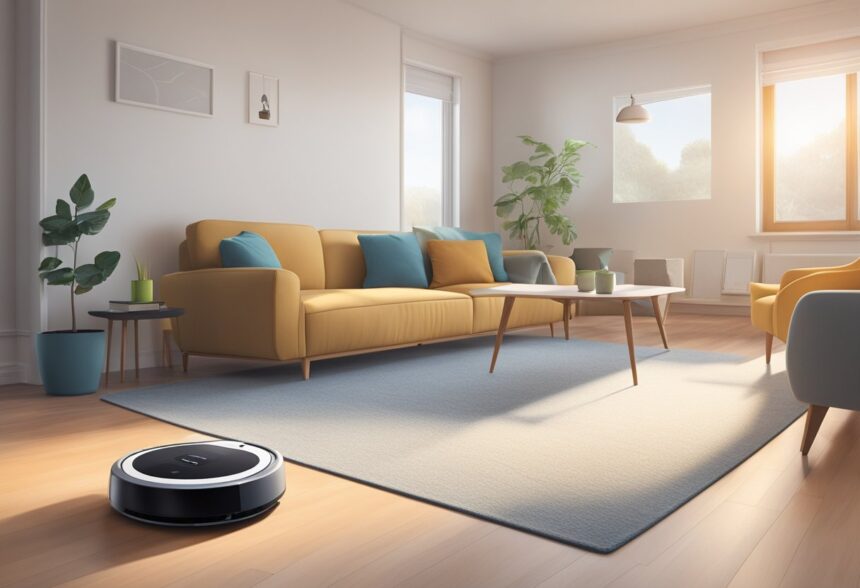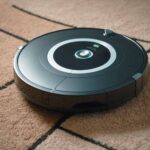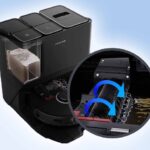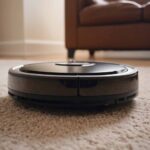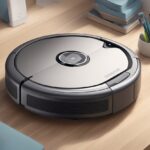Robot vacuums have become a staple for those seeking to reduce their time and effort in household chores.
The impact of robot vacuums on lifestyle is significant, offering a convenient solution to the often monotonous task of cleaning floors.
As they glide across various surfaces, these machines suction up dirt and debris, freeing up homeowners to focus on other activities. The trade-off between the cost of these devices and the time saved points to a broader societal trend valuing time over manual labor.
The availability of different models caters to various needs and preferences, from basic dust collection to more complex tasks like navigating around obstacles and optimizing cleaning routes.
Evolution of Robot Vacuums
The transition from traditional cleaning methods to automated home maintenance has been marked by significant milestones in robotics and technology, leading to the sophisticated robot vacuum cleaners we see today.
From Manual Sweepers to Intelligent Machines
In the 1990s, the concept of a robot vacuum cleaner was brought to life with devices that were relatively simple and manual in their design and capabilities.
One of the early pioneers, iRobot, launched the first popular autonomous cleaning robot, the Roomba, which revolutionized the way people perform the mundane task of vacuuming.
Over time, what began as novelty items with basic functions have transformed into intelligent machines.
They integrate seamlessly into the smart home ecosystem, communicating with other devices and their human users to provide a more hands-free experience.
Key Technological Advancements
As robot vacuum cleaners evolved, the technology driving them advanced remarkably. Here are some of the critical advancements:
- Sensors: These devices have grown from simple bump-and-go robots to sophisticated machines using sensors to navigate and map their environment, avoid obstacles, and even detect changes in floor surfaces.
- Performance: The overall performance of robot vacuum cleaners has improved dramatically, with increased suction power, better battery life, and the ability to handle different types of debris and flooring with ease.
- Connectivity: Integration with smart home systems allows users to control their robot vacuum cleaner via apps, making it possible to schedule and monitor cleaning sessions from anywhere.
| Advancement | Impact |
|---|---|
| Evolved Navigation | Efficiency in cleaning, enhanced ability to avoid obstacles |
| Improved Suction Power | More effective at picking up dirt and debris |
| Smart Home Integration | Simplified control and automation of cleaning tasks |
Through these advancements, robot vacuum cleaners have become essential tools in the modern home, melding convenience with performance, and continually adapting to the lifestyles of their users.
Analyzing the Impact on Household Cleaning
Robot vacuums have significantly changed the way cleaning is approached in the modern home. They offer convenience with preset cleaning schedules and handle pet hair and carpeting with varying degrees of effectiveness.
Automated Cleaning Schedules
Robot vacuums are equipped with the ability to set automated cleaning schedules. This allows them to maintain a level of cleanliness by operating at specified times, often when the home is empty.
Homeowners can program these devices to run daily or several times a week, ensuring that floors are regularly cleaned of dust and debris.
Pros:
- Ensures regular cleaning without manual intervention.
- Can target times when the home is less trafficked to avoid disruptions.
Cons:
- May miss spots if the home layout changes or obstacles are introduced after scheduling.
Challenges with Pet Hair and Carpeting
Pet owners often struggle with pet hair accumulation, and while robot vacuums are designed to tackle this, their efficiency varies.
Some models are specifically designed to handle pet hair, featuring specialized brushes and stronger suction power.
For Pet Hair:
- Specially designed brushes can effectively pick up hair.
- Regular maintenance of the vacuum’s brushes and filters is crucial for optimal performance.
For Carpets:
- While most robot vacuums manage well on hard floors, thick carpets can pose a challenge.
- They may require manual assistance for deep-cleaned carpets or for disentangling from fringes and long fibers.
Comparing Robot Vacuums to Traditional Vacuums
In the quest for household efficiency, the debate often centers on the merits of robot vacuums in comparison to traditional vacuums.
This comparison delves into the aspects of suction power and usability, as these factors greatly influence consumer choices.
Suction Power and Efficiency
Robot vacuums have seen impressive advancements in suction power, positioning them as formidable opponents to traditional upright vacuum cleaners.
While traditional vacuums tend to offer stronger suction due to their larger motors, robot vacuums compensate by providing smart navigation systems that cover areas multiple times if needed.
For instance, products such as the S8 Robot Vacuum offer a balance of technology and cleaning prowess that ensures thorough cleanliness.
| Vacuum Type | Suction Power | Preferred Use Case |
|---|---|---|
| Robot Vacuum | Moderate and systematic | Daily, lighter cleanups |
| Traditional Vacuum | High and direct | Deep, targeted cleanings |
Traditional vacuums, especially upright models, provide direct suction that is optimal for deep cleaning sessions. Their design caters to powerful, concentrated cleaning, making them better suited for dense carpets and heavy dirt accumulation.
Usability and Maintenance
Regarding usability, robot vacuums excel with autonomous, hands-free operation that fits seamlessly into busy lifestyles.
These vacuums can be scheduled and directed via smartphone apps, adding a level of convenience that upright vacuums cannot match.
Maintenance for robot vacuums, as highlighted by sources such as Living Smarter, typically involves simple tasks like emptying dust bins and replacing filters.
Traditional vacuums, on the other hand, might require more physical effort to maneuver, but they are often lauded for their straightforward, user-friendly maintenance.
Upright vacuums usually feature easily accessible compartments and longer-lasting bags that are simple to change, making them easier to repair and maintain.
| Vacuum Type | Usability | Maintenance Concerns |
|---|---|---|
| Robot Vacuum | High convenience | Regular emptying, battery care |
| Traditional Vacuum | Manual operation | Simple bag or bin replacement, occasional part fixes |
Each vacuum type brings distinct advantages to domestic cleaning, with robot vacuums catering to those valuing time and automated cleaning, while traditional vacuums appeal to users seeking thorough control and powerful cleaning capabilities.
Assessing Cost versus Convenience
When evaluating robot vacuums, consumers weigh the balance of upfront costs against the convenience and long-term benefits.
Operational expenses, including electricity and battery replacement, also play a significant role in the overall assessment.
Initial Investment and Long-Term Benefits
The initial cost of a robot vacuum can be considerable, but it’s essential to consider the long-term benefits.
These devices offer significant savings in terms of time and effort, as they automate the cleaning process and allow homeowners to multitask or relax.
High-end models might come with a steep price tag but typically feature more advanced navigation, superior cleaning abilities, and better efficiency, leading to savings over time.
Operational Costs and Battery Life
Operational costs for robot vacuums are mainly tied to electricity usage and battery life.
While they do use electricity, modern robot vacuums are designed to be energy-efficient, optimizing their cleaning paths to reduce power consumption.
The lifespan of these machines is often linked to their battery health, with most requiring a battery replacement a few years into their service. Notably, some batteries are more expensive but offer a longer life, reducing cost per use over time.
On average, robot vacuums are designed with a power rating ranging from 20 to 50 watts, with the majority hovering around 35 watts. This moderate power usage reflects the balance manufacturers strike between effective cleaning and energy efficiency.
For a robot vacuum with a power rating of 35 watts operating for approximately 1.5 hours daily, the estimated power consumption is about 52.5 watt-hours per day.
When extrapolated over a month, this usage amounts to roughly 1,575 watt-hours, or 1.575 kilowatt-hours.
It’s important to note that these figures are general estimates and can vary depending on the specific model, usage patterns, and vacuum settings. Nonetheless, this analysis offers a foundational understanding of the energy footprint of robot vacuums, illustrating their role as an eco-friendly addition to modern homes.
Let’s calculate the annual and 5-year costs, assuming an average robot vacuum price of $300 and annual maintenance costs of $50. I’ll calculate the energy consumption cost based on our earlier calculation of 1.575 kWh per month.
Here’s a cost table for a robot vacuum over a 5-year period, incorporating the calculated figures:
| Cost Category | Annual Cost (USD) | 5-Year Total (USD) |
|---|---|---|
| Purchase Cost | – | $300 |
| Annual Maintenance | $50 | $250 |
| Energy Consumption | $2.46 | $12.29 |
| Total Over 5 Years | – | $562.29 |
The most common items include dust bags (for models that use them), rollers or brushes, and filters. The frequency of replacement and the cost of these items can vary based on the vacuum model and usage. Here’s a simplified example table for maintenance costs over a 5-year period:
| Maintenance Item | Replacement Frequency | Cost per Replacement (USD) | Total Replacements Over 5 Years | Total Cost Over 5 Years (USD) |
|---|---|---|---|---|
| Dust Bags | Monthly | $3 | 60 (5 years) | $180 |
| Rollers/Brushes | Annually | $20 | 5 | $100 |
| Filters | Every 6 Months | $15 | 10 | $150 |
| Total | – | – | – | $430 |
Notes:
- Dust Bags: This cost applies to models that use disposable bags. The cost and replacement frequency can vary.
- Rollers/Brushes: These typically need replacement annually, but this can depend on usage.
- Filters: Frequent replacement is crucial for maintaining efficiency. The cost and frequency can vary based on the model.
- Total Cost Over 5 Years: This is the sum of all maintenance costs over a 5-year period.
This table provides a general overview. The actual costs will depend on the specific robot vacuum model, brand, and where you purchase the replacement parts. Remember, some high-end models might have more expensive parts, while others may be cheaper. If you have a specific model in mind, I can tailor this table to be more accurate. Let me know if you need further assistance!
Integration with Smart Home Ecosystems
Through Wi-Fi connectivity, robot vacuums offer unparalleled convenience, catering to user preferences and enhancing the functionality of living spaces.
Voice Activation and App Control
These devices, such as the iRobot Roomba j7+, can be instructed through simple voice commands to Amazon Alexa or Google Home, reflecting a significant leap in user interaction.
Homeowners can start, stop, or schedule cleaning sessions with phrases like “Alexa, ask Roomba to start cleaning.”
- Smartphone apps extend the control further:
- Remote scheduling: Set cleaning times regardless of your location.
- Custom cleaning preferences: Choose specific rooms for cleaning or set no-go zones.
The convenience of controlling a robot vacuum via smartphone is imperative for busy lifestyles, ensuring a clean home awaiting the user’s return.
Compatibility with Other Smart Home Devices
Interoperability is a cornerstone of the effective smart home ecosystem. Robot vacuums leverage this quality by working in tandem with other smart devices.
For example, they can pause cleaning when a smart doorbell detects a visitor, or they can dock themselves when the smart home system signals that the house is empty.
- Cross-device scenarios include:
- Environmental adjustments: Robot vacuums receive signals from smart thermostats to clean when the temperature is optimal.
- Security coordination: Integration with smart locks or security systems to navigate home cleaning when it’s safest to do so.
Compatibility with other devices ensures that the robot vacuum is a synergistic player in the larger smart home plan, contributing to an ecosystem that’s adaptive and intuitive to the homeowner’s needs.


